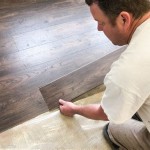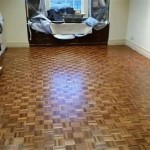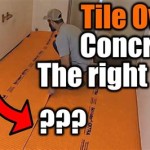Can You Put Lifeproof Flooring Directly On Concrete Floor?
Lifeproof flooring, known for its durability and stylish aesthetics, is a popular choice for various spaces, including homes, offices, and commercial buildings. But when installing Lifeproof flooring, a crucial question arises: can it be directly installed on a concrete floor? The answer is not a simple yes or no. While direct installation is sometimes possible, it depends on various factors, including the condition of the concrete subfloor and the type of Lifeproof flooring chosen.
This article delves into the intricacies of installing Lifeproof flooring on concrete, exploring the pros and cons of direct installation, the necessary steps to ensure a successful outcome, and alternative solutions if direct installation is not feasible. By understanding these factors, homeowners and contractors can make informed decisions regarding the best installation method for their specific project.
Understanding Concrete Subfloor Requirements
Before considering direct installation, it's crucial to assess the condition of the concrete subfloor. Lifeproof flooring requires a smooth, level, and dry subfloor to ensure proper installation and prevent future problems like squeaking, unevenness, and moisture issues. Here are some key aspects to consider:
1. Surface Levelness: The concrete subfloor should be level within a specific tolerance, typically measured using a level or a straight edge. An uneven subfloor can lead to gaps and unevenness in the Lifeproof flooring, affecting its appearance and performance. If the subfloor is not level, leveling compounds or self-leveling concrete can be used to create a smooth surface.
2. Moisture Content: Concrete can retain moisture, which can damage the Lifeproof flooring over time. The moisture content should be within acceptable limits to prevent warping, buckling, and mold growth. A moisture meter can be used to measure the moisture content of the concrete subfloor. If the moisture content is too high, a moisture barrier, such as a vapor retarder, may be necessary to prevent moisture from migrating to the flooring.
3. Surface Smoothness: The concrete subfloor should be smooth and free of debris, cracks, or unevenness. Any protrusions or defects can create unevenness in the Lifeproof flooring. If necessary, concrete can be ground or resurfaced to achieve a smooth surface.
Direct Installation of Lifeproof Flooring
Direct installation of Lifeproof flooring on concrete refers to installing the flooring directly on the concrete subfloor without using an underlayment. While possible, it's not always recommended. Here are some pros and cons to consider:
Pros
1. Cost-effective: Direct installation eliminates the cost of underlayment, making it a more budget-friendly option.
2. Thinner profile: Installing Lifeproof flooring directly on concrete creates a thinner floor profile, which is advantageous in low-ceiling spaces or when maintaining a certain floor height is essential.
3. Faster installation: Direct installation typically requires less time compared to installing over an underlayment, as it eliminates the additional step of laying down the underlayment.
Cons
1. Limited sound insulation: Direct installation offers minimal sound insulation, making it less ideal for spaces where noise reduction is a priority.
2. Increased risk of subfloor imperfections: Any existing imperfections in the concrete subfloor will be more pronounced with direct installation, as there is no underlayment to cushion the flooring.
3. Increased risk of damage from moisture: Direct installation can increase the risk of damage from moisture if the concrete subfloor is not adequately prepared or if it is exposed to high levels of moisture.
Alternative Solutions for Lifeproof Flooring Installation
If direct installation is not feasible, alternative solutions are available for installing Lifeproof flooring on concrete. These solutions are often preferable for improved sound insulation, moisture protection, and overall flooring performance.
1. Underlayment: Using an underlayment between the concrete subfloor and the Lifeproof flooring offers numerous benefits. It provides sound insulation, cushioning for a more comfortable walking experience, and moisture protection. Common types of underlayment include foam padding, cork underlayment, and rubber underlayment.
2. Moisture barrier: If the concrete subfloor is prone to moisture, a moisture barrier, such as a vapor retarder, should be installed to prevent moisture from reaching the Lifeproof flooring. This barrier helps prevent damage caused by moisture and promotes a healthier indoor environment.
Factors to Consider for Direct Installation
Before deciding on direct installation, several factors need careful consideration:
1. Lifeproof Flooring Type: Certain types of Lifeproof flooring, such as rigid core planks, are better suited for direct installation than others. Check the manufacturer's recommendations for specific flooring types.
2. Concrete Subfloor Condition: The condition of the concrete subfloor is paramount in determining the suitability of direct installation. A well-prepared, level, and dry subfloor is essential for successful direct installation.
3. Intended Use: Consider the area's intended use and whether noise reduction or moisture protection are critical factors. If so, direct installation may not be the best option.
Conclusion
Installing Lifeproof flooring directly on a concrete floor is a possible option, but it requires careful consideration of the concrete subfloor's condition, the type of Lifeproof flooring chosen, and the intended use of the space. By evaluating these factors, homeowners and contractors can make informed decisions regarding the best installation method for a successful and long-lasting flooring installation.

Tips For Installing Vinyl Plank Over Concrete Floors Lemon Thistle

Lvp Flooring Installation Over Concrete Subfloor Full Instructional Builds By Maz Flooret

How To Install Vinyl Plank Flooring Lifeproof Over Concrete

Why We Chose Lifeproof Vinyl Flooring And How To Install It

Why We Chose Lifeproof Vinyl Flooring And How To Install It

How To Install Vinyl Or Laminate Floors In A Basement Over Concrete Slab

How To Install Lifeproof Flooring The Home

Why We Chose Lifeproof Vinyl Flooring And How To Install It

How To Install Lifeproof Flooring The Home

Why We Chose Lifeproof Vinyl Flooring And How To Install It
See Also







